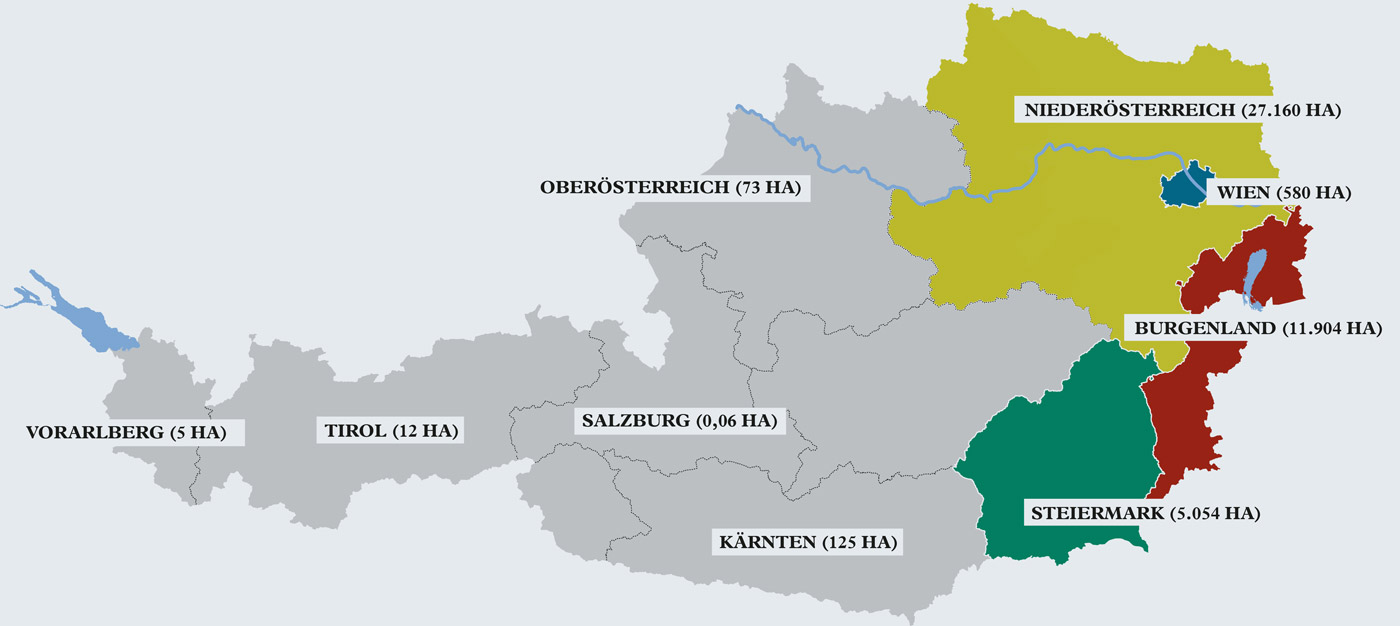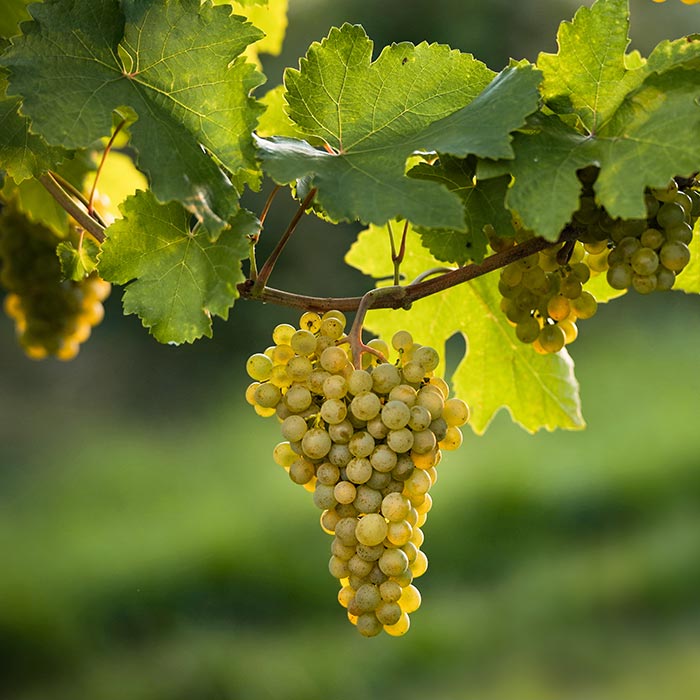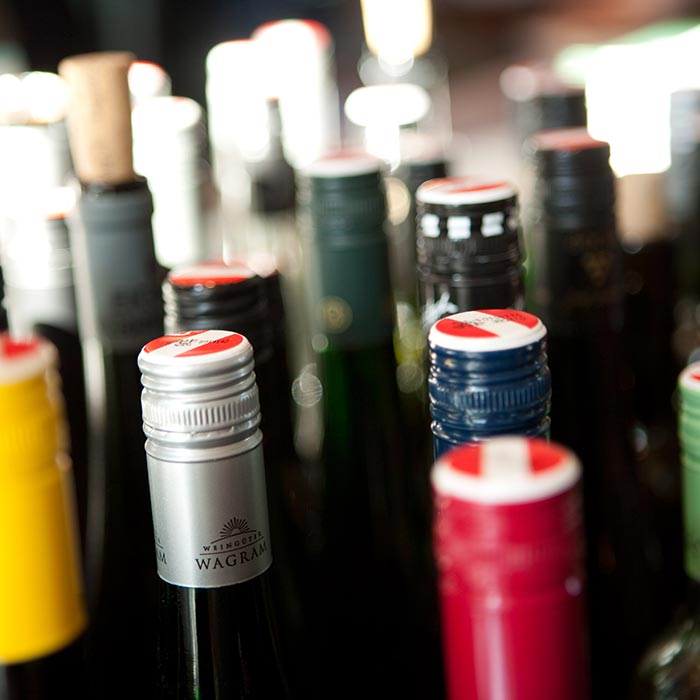Austria is called the "Alpine Republic". But this is only partially true for wine: Although the country's highest vineyard is at almost 1,100 metres in Tyrol, most of the approximately 45,000 hectares of vineyards are distributed around the eastern edge of the mountain range at lower altitudes and under continental, Pannonian to Mediterranean climatic influences. Since the late 1980s, Austria's wine industry has been modernised and has taken an enormous qualitative upswing, which has also established the country internationally as a source of top wines. This included the start of marketing based on the origin of the wines.
Austria's wine geography initially follows the three-level division into wine regions, generic wine-growing areas and specific wine-growing areas.
There are three wine-growing regions: the Weinland region covers the provinces of Lower Austria, Burgenland and Vienna; the Steirerland region corresponds to the province of Styria; the Bergland region covers all other provinces (Carinthia, Upper Austria, Salzburg, Tyrol and Vorarlberg).
 |
In the further subdivision, the wine-growing regions Weinland and Steirerland are composed of so-called generic wine-growing regions. Geographically, these are the federal provinces that are located in these regions. The generic wine-growing regions are further subdivided into smaller sub-regions. These are the specific wine-growing regions:
Except for Thermenregion, the specific wine-growing areas are also the areas that bear the status of "Districtus Austriae Controllatus" (DAC). Wines with this protected designation of origin are quality wines that are particularly typical of the region and must meet specific quality criteria.

For a long time, wine quality in Austria was primarily determined by must weight. It is an indication of the physiological ripeness of the grapes and is defined as the sum of all dissolved substances in the grape must. In Austria, it is expressed in degrees KMW (Klosterneuburger Mostwaage). The principle is: the higher the must weight, the higher the wine quality.
The must weight also determines the predicate levels of Austrian wines: Spätlese, Auslese, Ausbruch, Beerenauslese, Trockenbeerenauslese, Strohwein, Eiswein, In some cases, the influence of the noble fungus Botrytis cinerea also comes into play here; the fungus makes the grape skin porous, so that the water evaporates and the ingredients (especially the sugar) concentrate in the grapes.
In 2009, the EU wine market reform declared the principle of origin as the authoritative quality system for the wines of the EU member states. The principle of this principle is: the closer the origin, the higher the wine quality. This means: the smaller the geographical unit from which its grapes come, the better the wine. The country of origin is the largest geographical unit and a single vineyard (Lage, österr. Riede) is the smallest.
As early as the beginning of the 2000s - almost a decade before the principle of origin became "official" with the EU wine market reform - Austria introduced an origin-based quality model with the DAC system, which almost all specific wine-growing regions have joined in the meantime.
 |
Wines that want to bear the designation "Districtus Austriae Controllatus" must be quality wines according to wine law and fulfil further, precisely defined qualitative requirements. For example, the grape varieties from which the wines may be pressed are prescribed for the DAC wines of each individual region. Further specifications refer to the must weight of the grapes, the harvest quantity, the residual sugar and alcohol content of the wine, as well as cellar-technical aspects such as pressing method, type of maturation and maturing time in the cellar. Taking all these criteria into account, a DAC wine must be typical of its region.
Like all quality wines, a DAC wine must undergo official analytical and sensory tests before it can be marketed in order to receive the state test number. Depending on the region of origin, DAC wines are additionally subdivided into certain categories: depending on the ripening period and alcohol content, into Classic and Reserve wines, and depending on the narrowness of the origin, into Area wines, Local wines and single vineyard wines (single vineyards).
Wines that are produced in a specific wine-growing region (usually a DAC region) from grapes cultivated there, but do not meet all the regulations that apply there, bear the higher-level generic region designation - for example Lower Austria, Burgenland and, Styria. If a wine does not fully meet their criteria either, it bears the designation "Wine from Austria".

In 2001, regional wine committees were established in Austria, which are made up of those responsible for the wine industry in the respective region and whose work is monitored and coordinated by the higher-level National Wine Committee. They are to elaborate regionally typical wine styles and help to better market their area and its wines. This was the foundation stone for the DAC system.
In 2003, the protected designation "Weinviertel DAC" was introduced as the first regionally typical indication of origin. Mittelburgenland DAC" and "Traisental DAC" followed in 2006, "Kremstal DAC" in 2007 and "Kamptal DAC" in 2009. In 2010 "Leithaberg DAC" and "Eisenberg DAC" were added, in 2012 "Neusiedlersee DAC" and in 2013 "Wiener Gemischter Satz DAC".
In 2016, the quality pyramid "Österreichischer Sekt g.U." with the three levels Klassik, Reserve and Große Reserve came into force; since 2021, this designation of origin has been called "Sekt Austria".
In 2018, "Rosalia DAC" as well as "Weststeiermark DAC", "Südsteiermark DAC" and "Vulkanland Steiermark DAC" increased the number of protected designations of origin for wines typical for the region into double figures; with "Carnuntum DAC" since 2019, "Wachau DAC" and "Ruster Ausbruch DAC" since 2020 as well as "Wagram DAC" since 2021, there are currently 17 regions.
Photos: ÖWM / WSNA, ÖWM / Bernhard Schramm